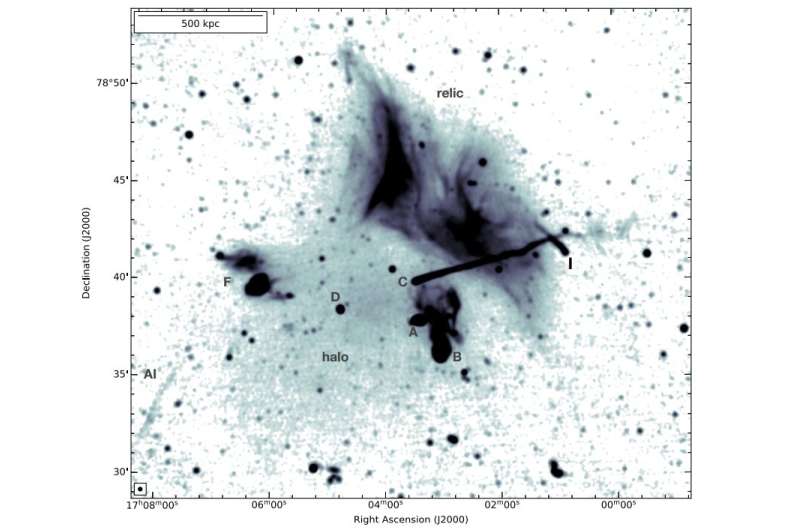September 19, 2022 report
Radio halo in galaxy cluster Abell 2256 investigated in detail

Using various radio telescopes, an international team of astronomers has performed deep low-frequency radio observations of a merging galaxy cluster Abell 2256. The observational campaign delivered more insights into the properties of the cluster's radio halo. The findings were detailed in a paper published September 7 on arXiv.org.
Radio halos are enormous regions of diffuse radio emission, usually found at the centers of galaxy clusters. However, diffuse emissions generally have very low surface brightness, particularly at GHz frequencies, which makes them hard to detect. Their brightness increases at lower frequencies, unveiling the presence of these regions.
With the capability of obtaining deep, high-resolution, high-fidelity and low-frequency radio images, the LOw Frequency ARray (LOFAR) is an excellent tool for studying radio halos at low frequencies with unprecedented detail and sensitivity. Therefore, a group of researchers led by Kamlesh Rajpurohit of the University of Bologna in Italy, has employed LOFAR in order to inspect radio halo in Abell 2256—a nearby (at a redshift of 0.058) massive galaxy cluster exhibiting strong emission at all wavelengths. The team also used the upgraded Giant Metrewave Radio Telescope (uGMRT) and the Karl G. Jansky Very Large Array (VLA) to observe this halo.
"We present the first detailed analysis of the radio halo in the merging galaxy cluster Abell 2256 using the LOw Frequency ARray (LOFAR), the upgraded Giant Metrewave Radio Telescope (uGMRT) and the VLA. Radio observations (120 MHz-2 GHz) combined with archival Chandra and XMM-Newton X-ray data allowed us to study the halo emission with unprecedented detail," the researchers wrote in the paper.
The astronomers managed first deep, high spatial resolution radio images of Abell 2256's radio halo. The halo emission was detected by them at all frequencies, namely 144 MHz, 350 MHz, 675 MHz and 1.5 GHz. The largest linear size of this halo was measured to be about 2.93 million light years at 144 MHz and 1.63 million light years at 1.5 GHz, which suggests that its outermost region has a steep spectrum.
In general, the study found that emission from the halo follows a power-law spectrum between 144 MHz and 1.5 GHz, and has an ultra steep spectrum with an integrated spectral index of −1.63. Moreover, the spatially resolved spectral index maps revealed a spectral steepening with increasing radius.
The research found that the morphology of the radio halo is remarkably similar to that in X-rays. In particular, the X-ray peak in the main mass component coincides with the radio peak. Furthermore, the point-to-point comparison between the radio and X-ray surface brightness across the halo indicates a strong sublinear correlation.
The observations also revealed a strong anti-correlation between the spectral index and the X-ray surface brightness across the halo. According to the researchers, this is consistent with radial steepening.
Summing up the results, the authors of the paper underlined that the properties of radio halo in Abell 2256 make it a very peculiar object, whose further investigation may advance our knowledge about particle acceleration mechanisms on very large scales.
More information: K. Rajpurohit et al, Deep low-frequency radio observations of Abell 2256 II: The ultra-steep spectrum radio halo. arXiv:2209.03288v1 [astro-ph.CO], arxiv.org/abs/2209.03288
© 2022 Science X Network





















